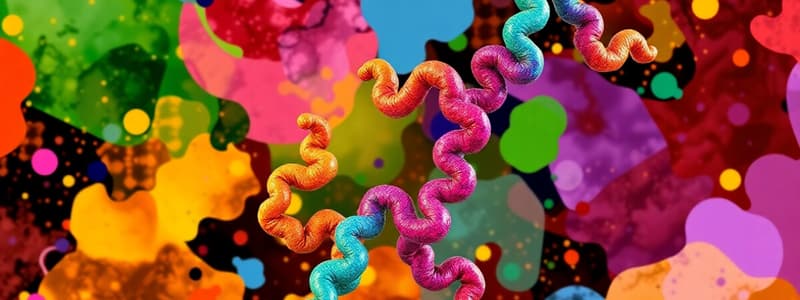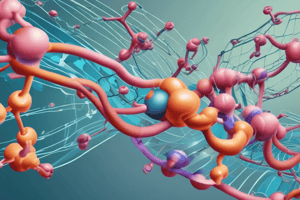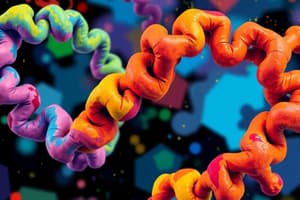Podcast
Questions and Answers
What role do hydrogen bonds play in the formation of β-sheets?
What role do hydrogen bonds play in the formation of β-sheets?
Hydrogen bonds stabilize the sheet-like structure of β-sheets formed by segments of polypeptide chains.
How does the tertiary structure differ from the primary structure of a protein?
How does the tertiary structure differ from the primary structure of a protein?
The tertiary structure refers to the three-dimensional conformation of a protein, whereas the primary structure is the linear sequence of amino acids.
What are protein domains and what significance do they have?
What are protein domains and what significance do they have?
Protein domains are structural parts of a protein that can fold and function independently, often determining functional characteristics.
Describe the quaternary structure and provide an example of a protein that exhibits this structure.
Describe the quaternary structure and provide an example of a protein that exhibits this structure.
What is the main consequence of misfolded proteins in the context of aging?
What is the main consequence of misfolded proteins in the context of aging?
What role do chaperones play in protein folding?
What role do chaperones play in protein folding?
What stabilizes the tertiary structure of proteins?
What stabilizes the tertiary structure of proteins?
In terms of protein structure, what does the term 'domains' imply about a protein's functionality?
In terms of protein structure, what does the term 'domains' imply about a protein's functionality?
Define protein denaturation and its impact on protein structure.
Define protein denaturation and its impact on protein structure.
What defines the primary structure of a protein?
What defines the primary structure of a protein?
What factors can cause protein denaturation?
What factors can cause protein denaturation?
How do polypeptide subunits in proteins interact at the quaternary level?
How do polypeptide subunits in proteins interact at the quaternary level?
Describe the consequences of protein denaturation on biological activity.
Describe the consequences of protein denaturation on biological activity.
What is the cellular response to misfolded proteins, and what are the limitations of this process?
What is the cellular response to misfolded proteins, and what are the limitations of this process?
How do genetic diseases relate to the primary structure of proteins?
How do genetic diseases relate to the primary structure of proteins?
Why is the understanding of protein folding significant in the context of diseases such as Alzheimer’s?
Why is the understanding of protein folding significant in the context of diseases such as Alzheimer’s?
What are the two main types of secondary structure in proteins?
What are the two main types of secondary structure in proteins?
Explain how hair treatments utilize the concept of denaturation.
Explain how hair treatments utilize the concept of denaturation.
What stabilizes the secondary structure of a protein?
What stabilizes the secondary structure of a protein?
What happens to a protein's peptide bonds during denaturation?
What happens to a protein's peptide bonds during denaturation?
Describe the structure and orientation of the α-helix.
Describe the structure and orientation of the α-helix.
How does temperature above 70°C affect proteins?
How does temperature above 70°C affect proteins?
What are simple proteins, and how are they classified?
What are simple proteins, and how are they classified?
Explain the significance of protein folding.
Explain the significance of protein folding.
Describe how strong acids and alkalis affect proteins.
Describe how strong acids and alkalis affect proteins.
How are amino acids in a secondary protein structure arranged?
How are amino acids in a secondary protein structure arranged?
What is the significance of heat shock proteins in cellular stress responses?
What is the significance of heat shock proteins in cellular stress responses?
What effects does denaturation have on proteins?
What effects does denaturation have on proteins?
How does primary structure influence other protein structures?
How does primary structure influence other protein structures?
In what way can α-helix and β-pleated sheet coexist within a protein?
In what way can α-helix and β-pleated sheet coexist within a protein?
What are glycoproteins and their role in cellular functions?
What are glycoproteins and their role in cellular functions?
Describe the structural characteristics that differentiate fibrous proteins from globular proteins.
Describe the structural characteristics that differentiate fibrous proteins from globular proteins.
What functions do keratins serve in the human body?
What functions do keratins serve in the human body?
Explain the significance of lipoproteins in lipid transport.
Explain the significance of lipoproteins in lipid transport.
How do myoglobin and hemoglobin differ in their functions within the body?
How do myoglobin and hemoglobin differ in their functions within the body?
What is the primary reason fibrous proteins are resistant to enzymatic digestion?
What is the primary reason fibrous proteins are resistant to enzymatic digestion?
Identify a major characteristic of globular proteins that allows them to function as enzymes.
Identify a major characteristic of globular proteins that allows them to function as enzymes.
What determines the flexibility of keratin in different tissues?
What determines the flexibility of keratin in different tissues?
How do the classifications of proteins based on shape affect their biological functions?
How do the classifications of proteins based on shape affect their biological functions?
What role do plasma albumins play in the circulatory system?
What role do plasma albumins play in the circulatory system?
Flashcards are hidden until you start studying
Study Notes
Orders of protein structure
- The linear sequence of amino acids in a protein is known as its primary structure.
- Primary structure determines the higher levels of protein structure (secondary, tertiary, and quaternary).
- The primary structure is essential for protein function, and mutations can lead to diseases.
- Secondary structures involve regular repeating arrangements of amino acid residues in a polypeptide chain.
- The α-helix and β-pleated sheet are the two main types of secondary structures.
- Tertiary structures are formed by the three-dimensional folding of a polypeptide chain.
- Tertiary structures are stabilized by interactions between side chains, ionic interactions, disulfide bonds, and hydrogen bonds.
- Domains are three-dimensional structures that are structurally independent and can fold and function on their own within a protein.
- The Quaternary structure involves the assembly of multiple polypeptide chains (subunits) into a functional protein.
- Quaternary structures are essential for the function of many proteins, such as hemoglobin.
- Subunits in quaternary structures are held together by non-covalent interactions.
Protein Folding and Diseases
- Misfolded proteins can accumulate within cells, contributing to diseases like Parkinson's and Alzheimer's.
- Chaperone proteins assist in proper protein folding and prevent misfolding.
- Heat shock proteins are chaperones that are upregulated in response to heat stress.
What is protein "Denaturation"?
- Denaturation involves the loss of secondary and tertiary structures while retaining the primary structure.
- Denaturation occurs due to the disruption of non-covalent bonds.
- Denatured proteins lose their biological functions.
Causes of Denaturation
- Physical factors: High temperatures, vigorous vibration, ionizing radiation, X-rays, and high pressure.
- Chemical factors: Strong acids, alkalis (extreme pH), and Urea.
Effects of Denaturation
- Loss of biological activity of enzymes and hormones
- Altered antigenic properties of proteins.
- Denatured proteins become easier to digest due to unfolding of peptide chains.
How are proteins Classified?
- Simple proteins are composed only of amino acids.
- Examples: Plasma albumin and collagen.
- Conjugated proteins contain a non-protein component.
- Examples: Glycoproteins, Lipoproteins.
Classification Based on Shape
- Fibrous proteins: Elongated strand-like structures.
- Functions: Mechanical and structural.
- Examples: Keratins.
- Globular proteins: Compact and spherical structures.
- Functions: Enzymes, hormones, membrane transporters, and receptors.
- Examples: Myoglobin and Hemoglobin.
Studying That Suits You
Use AI to generate personalized quizzes and flashcards to suit your learning preferences.




